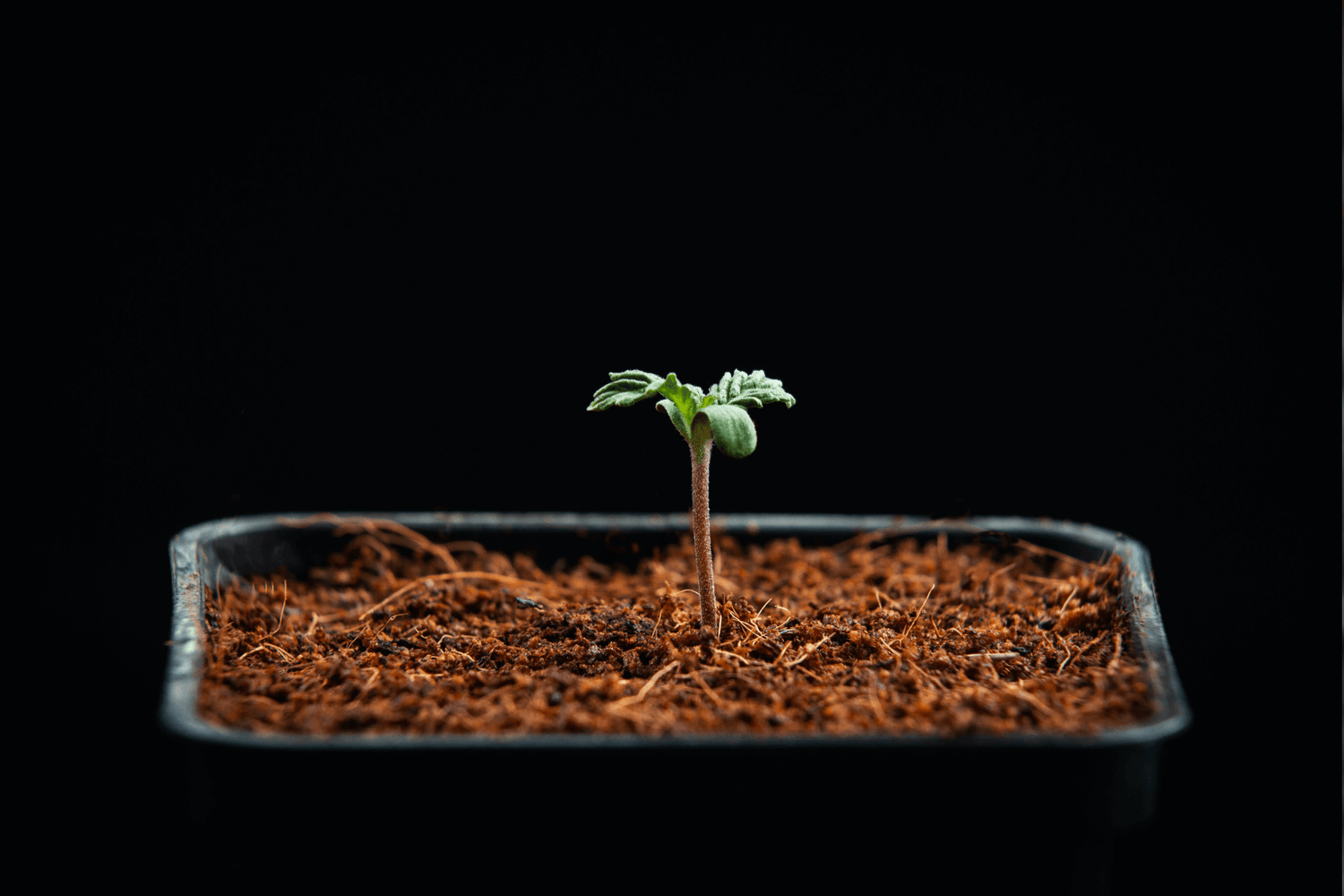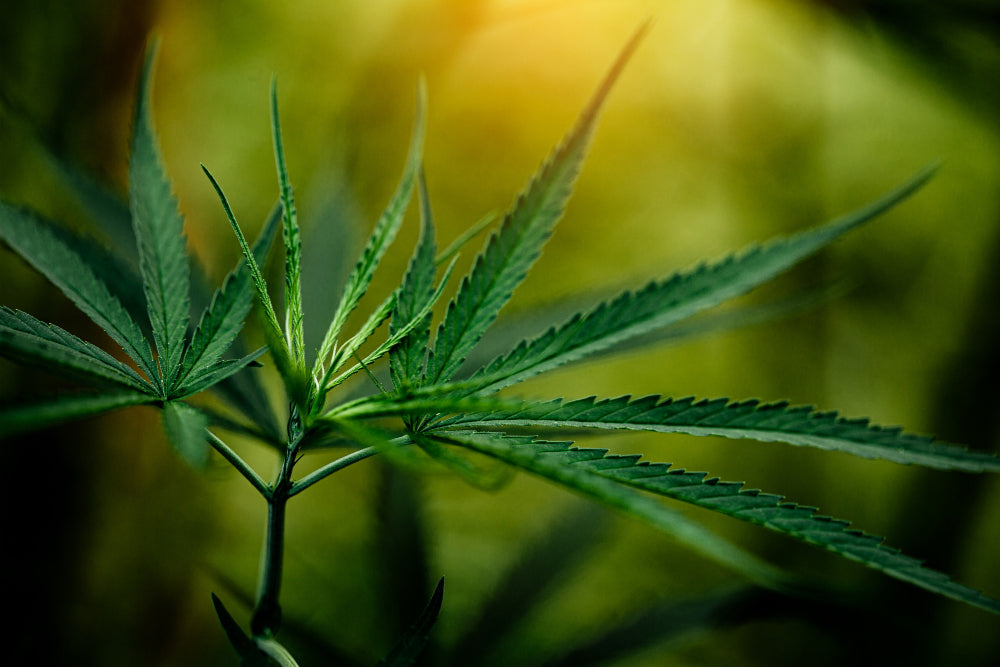Inhaltsverzeichnis
- Why the First Week Is So Important for Hemp Seedlings
- 1 week old hemp seedling: development and first signs of health
- Care of a 1-week-old hemp seedling: light, temperature, and humidity
- 1 week old autoflowering hemp seedling: special care
- Correct watering: Avoiding mistakes with 1-week-old hemp seedlings
- Damping-off: Protecting your 1-week-old hemp seedling
- Repotting: When and how to repot a 1-week-old hemp seedling?
- Conclusion: 1 week old hemp seedling – the foundation for healthy plants
The first week in the life of a hemp seedling is a bit like the first day of school – exciting, full of possibilities, but also sensitive. Your little hemp seedling is currently struggling through its first few days, carefully stretching its roots and searching for the perfect balance of light, water, and warmth. And right now, you decide whether this delicate plant will develop into a strong, productive plant. With the right care and a few clever tips, you can give it the best start in its plant life. From proper watering to disease prevention – the next steps are crucial to creating a healthy foundation for your little green friend.
Why the First Week Is So Important for Hemp Seedlings
Starting your hemp cultivation is like laying the foundation of a house—without a solid beginning, the entire growth process could falter. The first week determines whether your hemp seedling will be strong and resilient. Proper care is crucial now to avoid future problems and create a healthy foundation for future development.
A one-week-old cannabis seedling may appear delicate and fragile, but it's already laying the foundation for its future life during this phase. If you give it the attention it needs now, chances are you'll get a strong plant with a bountiful harvest later. There are a few things to consider: the right amount of light, optimal humidity and temperature, and special care for autoflowering seedlings. In this article, you'll learn everything you need to keep in mind during the first week to provide the best possible support for your little bud.
1 week old hemp seedling: development and first signs of health
After a week, your hemp seedling will begin to develop from an inconspicuous seed into a small plant. It will now display its first tiny leaves, known as cotyledons. These are the first sign that your seedling has found its way into growth. At the same time, it will work intensively on developing its root system. Why is this so important? Good root development ensures that the plant can optimally absorb nutrients later on – this is the foundation for a healthy and productive hemp plant.
A watchful eye is required during this phase. A healthy 1-week-old hemp seedling is upright, has green cotyledons, and shows no signs of discoloration or weakness. To better assess the health of your seedling, pay attention to the following points:
- Color: The cotyledons should be a lush green. Yellow or brown discoloration may indicate nutrient deficiency or overwatering.
- Posture: A strong seedling stands upright. A "sprouting" seedling that stretches out and falls over indicates a lack of light.
- Moisture: The soil should be moist, but not soggy. Waterlogging can damage the roots and inhibit growth.
If your seedling exhibits these characteristics, it's on the right track. However, if it shows signs of weakness, such as paleness or excessive stretching, this could indicate problems like insufficient light or improper moisture. Don't worry, there are plenty of ways to help it get back on track!
The most important thing now is to avoid stress. Your seedling is still very sensitive, so consistent conditions are essential. With proper care, you'll lay the foundation for a strong plant.
Care of a 1-week-old hemp seedling: light, temperature, and humidity
A one-week-old hemp seedling has very specific needs for optimal development. During this phase, the right mix of light, temperature, and humidity is crucial. If you create the perfect conditions now, you'll lay the foundation for a healthy and strong plant.
Light requirements for your hemp seedlingYour little seedling needs sufficient light to grow strong and stable. Without enough light, it tends to stretch and become unstable. An 18-hour light cycle is ideal to provide it with enough energy. The light source should be about 30-50 cm away from the plant to avoid burning.
Optimal temperature and humidityThe right temperature and humidity are also crucial for the health of your seedling. Here are a few guidelines to keep in mind:
- Temperature: Keep the temperature between 20-25°C. Too high temperatures can dry out the seedling, while too low temperatures can slow growth.
- Humidity: A humidity level of 50-70% is optimal. This allows the seedling to hydrate its small leaves without the risk of mold growth.
- Ventilation: Ensure the area is well ventilated. Fresh air prevents mold and mildew growth, which is very important during this delicate period.
Be careful when watering, as a one-week-old hemp seedling doesn't need large amounts of water. Overwatering is a common mistake that can lead to root rot.
- Tip: It's best to use a spray bottle to moisten the soil evenly without overwatering the delicate seedling. Water only when the top layer of soil is slightly dry.
If you follow these care instructions, your little hemp seedling will develop the perfect foundation for a healthy plant.

1 week old autoflowering hemp seedling: special care
Autoflowering strains are extremely popular, primarily due to their uncomplicated and rapid growth phase. If you have a one-week-old autoflowering cannabis seedling, there are a few things to keep in mind when caring for it. While the basic care requirements are similar to those of photoperiod plants, there are a few unique considerations.
Faster growth, faster reactionsAutoflowering cannabis strains tend to grow faster, meaning they can be a bit more robust during the first week. However, proper care is crucial to fully exploit the plant's potential.
- Early repotting: Autoflowering plants are more sensitive to transplant stress. Repotting should therefore be avoided if possible. Plant the seedling directly into the final pot to avoid stress and growth delays.
- Nutrients: Autoflowering cannabis plants don't require any additional fertilization during the first week. Too much fertilizer can quickly lead to burn. Therefore, wait at least until the second week before adding a light dose of nutrients.
- Light cycle: One advantage of autoflowering strains is their flexibility. An 18/6 light cycle is ideal, but they can also cope with 20 hours of light per day. This gives them an extra dose of energy for their rapid growth.
To ensure your autoflowering hemp seedling grows healthy and strong, you should pay attention to the following things:
- Avoid asparagus: Since autoflowering strains grow quickly, a lack of light can cause the seedling to "asparagus." Make sure the light source isn't too far away.
- Temperature and humidity: The usual rules apply here too – 20-25°C and a humidity of 50-70%. Autoflowering seedlings are somewhat more resilient, but consistent conditions are still important.
With proper care and a watchful eye on the specific needs of your autoflowering seedling, you can ensure optimal growth. After all, a bountiful harvest depends largely on a successful start!
Correct watering: Avoiding mistakes with 1-week-old hemp seedlings
Watering is one of the most important aspects of caring for your 1-week-old hemp seedling—and also a common source of error. Too much water can damage the delicate roots and even encourage the dreaded damping-off disease, while too little water can stunt growth. So, it's all about finding the right balance.
How to Water Your Seedling Correctly
A one-week-old hemp seedling doesn't need large amounts of water. During this phase, it's crucial to keep the soil evenly moist without causing waterlogging. Here are a few practical tips for proper watering:
- Amount: Use a spray bottle to lightly moisten the top layer of soil. Avoid watering directly onto the seedling to avoid flooding the tender roots. A few sprays per day are often sufficient.
- Frequency: Wait until the top layer of soil has dried slightly before watering again. The soil should be moist, but not wet. Wet soil encourages mold and mildew growth, which can harm the young seedling.
- Water quality: It's best to use filtered or stale tap water to reduce harmful substances like chlorine. You can also add a few drops of root stimulator to the water to promote root growth.
Signs of over- or underwatering
To ensure you're providing the right amount of water, monitor your seedling closely. Here are a few signs to look out for:
- Overwatering: Yellow leaves, a limp appearance, and a soft, dark stem indicate that your seedling is getting too much water. If you notice these signs, let the soil dry out thoroughly before watering again.
- Underwatering: Dry soil and wilting leaves are signs that your seedling isn't getting enough water. If this happens, immediately moisten the top layer of soil with a spray bottle, but don't overdo it!
With the right watering technique, you lay the foundation for a strong root system and a healthy plant. Practice makes perfect, so be patient and observe your plant—it will tell you what it needs!
Damping-off: Protecting your 1-week-old hemp seedling
Damping-off disease is one of the most common reasons why young cannabis seedlings die within the first week. It's caused by soil-borne fungi that attack and weaken the seedling's stem until it eventually topples over. It sounds dramatic, but don't worry! With proper care and a few precautions, you can protect your seedling from this disease.
How do you recognize the fallopian tube disease?
The first signs of damping-off disease are relatively easy to detect if you check your seedling regularly:
- Stem discoloration: The stem begins to turn dark at the base, often accompanied by a constriction, as if the stem were being “strangled”.
- Weak growth: The seedling appears limp and eventually falls over because the weakened stem can no longer support the weight.
- Watery soil: Constantly wet soil can encourage the growth of fungi that cause damping-off.
Prevention: How to keep the fall-off disease at bay
Damping-off disease is feared, but with the right measures you can effectively protect your 1-week-old hemp seedling from it:
- Ventilation: Ensure good air circulation around your seedlings. A small fan gently blowing air onto the seedlings promotes strong stems and dries out excess moisture.
- Sterile potting soil: Use high-quality, sterile potting soil to minimize the risk of fungal infections. The soil should also have good drainage so excess water can drain away quickly.
- Moderate watering: As mentioned above, less is more. Keep the soil only slightly moist and allow the top layer to dry out before watering again.
- Spray bottle: Use a spray bottle when watering to moisten the soil without overwatering it. This reduces the risk of fungal growth.
What to do if it has already happened?
If you notice the first signs of fallopian tube disease, act immediately:
- Drying: Allow the soil to dry as much as possible to stop the fungi from spreading further.
- Increase ventilation: Increase ventilation and ensure that the ambient temperature remains constant at 20-25°C.
- Cinnamon: A tried and tested home remedy is to sprinkle the affected soil with some cinnamon powder, as it has a natural antifungal effect.
Remember: prevention is the best cure! By controlling the conditions for your cannabis seedling, you can prevent damping-off from spreading in the first place.
Repotting: When and how to repot a 1-week-old hemp seedling?
Repotting is a crucial step in the life of your cannabis seedling. You should be especially careful with autoflowering plants, as they are particularly sensitive to stress. But don't worry! With the right preparation and approach, repotting will be a breeze. But when is the right time, and what's the best way to go about it?
When is the right time to repot?
A one-week-old cannabis seedling is still in a sensitive growth phase. Generally speaking, the less stress the plant experiences during this time, the better. For autoflowering cannabis seedlings, it's even advisable to plant them directly into their final pot to avoid unnecessary stress. For photoperiod plants, you can look for these signs:
- Root development: When the roots begin to grow out of the drainage holes of the growing container, it is time to repot.
- Size of the seedling: Once the seedling has developed its first or second pair of leaves (after the cotyledons), it is strong enough to be moved.
How do you repot properly?
Repotting requires a little bit of dexterity, but with the right steps it works without any problems:
- Preparation: Choose a pot of the right size (at least 10-15 liters for the final pot) and fill it with high-quality soil. Make sure the soil is slightly moistened, but not soaking wet.
- Loosening the plant: Gently squeeze the seedling pot from all sides to loosen the soil. Turn the pot upside down, gently hold the seedling between your fingers, and tap the bottom of the pot until the root ball comes loose.
- Planting: Place the seedling, including its root ball, into a previously prepared hole in the new pot. Carefully cover the roots with soil and lightly press it down to stabilize the plant.
- Watering: Water the plant lightly to settle the soil and moisten the roots. It's best to use a spray bottle to avoid waterlogging.
Tips for stress-free repotting
To make repotting your hemp seedling as stress-free as possible, follow these tips:
- Timing: Always repot during the dark phase or in the early morning hours when the plant is less stressed.
- Be careful with the roots: Be careful not to damage them. Work gently and avoid pulling on them.
- Moisten the soil: Lightly moisten the soil in the new pot before planting the seedling. This facilitates root development and reduces shock to the plant.
With the right approach, repotting isn't rocket science and will help your hemp seedling establish a strong root system in its new pot and continue to grow vigorously. Once repotted, it now has enough space to spread its roots and establish a strong foundation for the next growth phase.
Conclusion: 1 week old hemp seedling – the foundation for healthy plants
A one-week-old cannabis seedling may still appear small and delicate, but this is precisely when you are laying the foundation for its future growth and health. Proper care during this sensitive phase will determine whether your seedling will develop into a strong and productive plant.
This first week is all about the basics: sufficient light , a constant temperature of 20-25°C, and a humidity of 50-70%. Make sure the seedling doesn't "spread over," receives sufficient water without the soil being too wet, and is protected from fungal infections such as damping-off.
The right balance of watering, good ventilation, and avoiding stress factors like repotting too early are essential. Especially with autoflowering strains, it's important to plant directly in the final pot to avoid unnecessary stress. If you do decide to repot, be careful and choose the right time to minimize the shock to the plant.
Remember: Every step you take now will have a direct impact on the future development of your cannabis plant. With patience, a watchful eye, and the right care, you can ensure your seedling gets off to a good start in the next phase and lays a healthy foundation for a bountiful harvest.
Now it's your turn! Observe your seedling, learn its needs, and be prepared to make small adjustments. The better you support it during this early stage, the more you'll benefit later. Your cannabis cultivation adventure has just begun—and with the right care, you'll soon reap the rewards of your labor!






Leave a comment
This site is protected by hCaptcha and the hCaptcha Privacy Policy and Terms of Service apply.